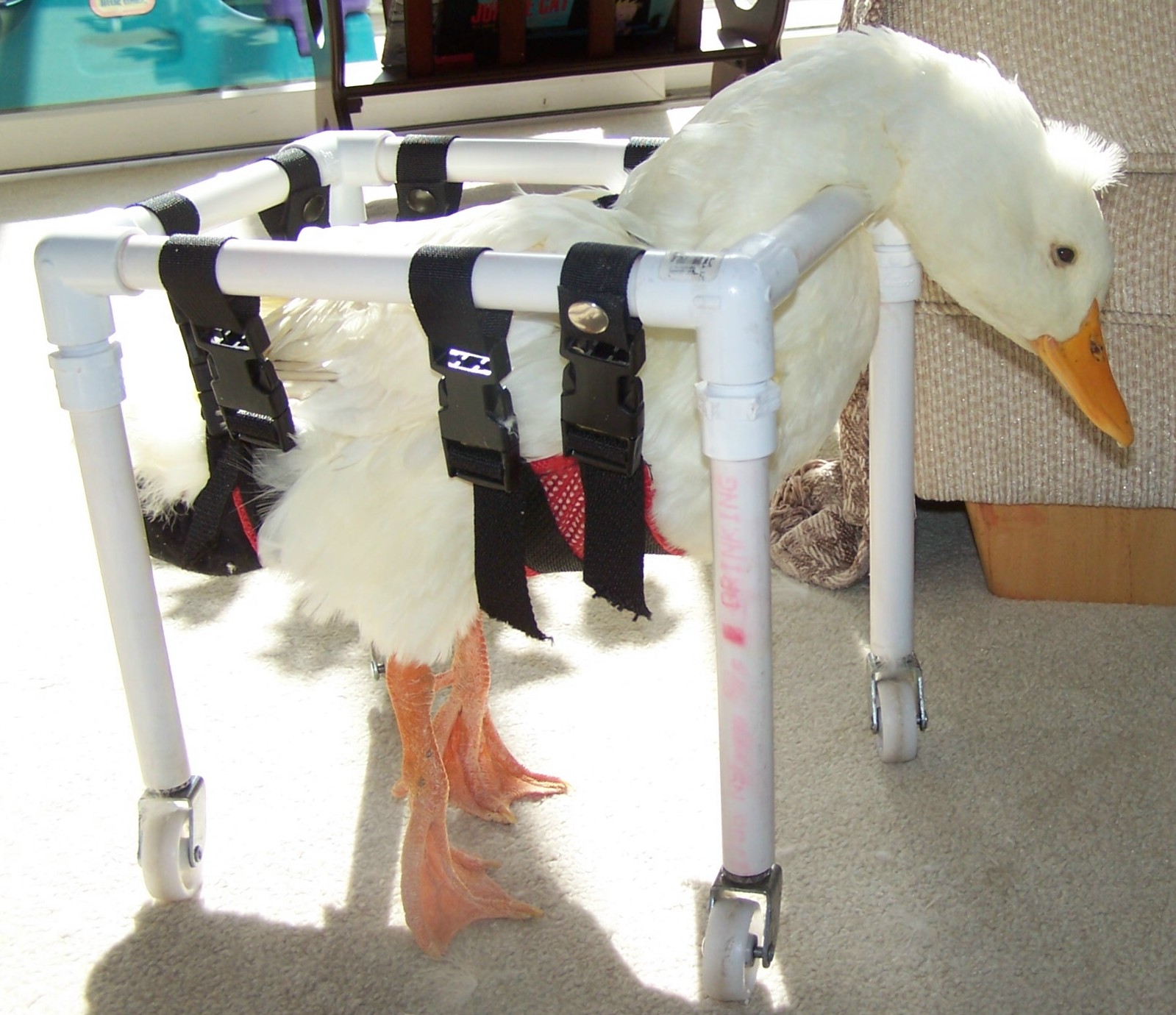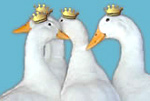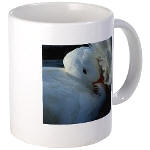Making a Duck Wheelchair
When
preparing for Roberta duck's surgery, we had to
make a post surgical wheelchair for her recovery
period. We found that a simple mesh laundry
sorter contained most of the parts needed to
assemble a ducky wheelchair, including the mesh
for making your duck's harness. The only
additional parts we needed to purchase were six buckles with straps. We found both of these
products at our local Walmart.
The PVC pipes included in the laundry sorter will need to be measured and cut down to size and you will also need to do a bit of measuring, cutting and sewing to make your duck's buckled harness, which will hold them in place.
The completed wheelchair should look something like this:
Here is a photo of our friend Lemon in her wheelchair.

Remember: Ducks must be continually supervised while in their wheelchair. Additionally, they should only be used on flat surfaces.
Emergency Care, Surviving a Predatory Attack
Unfortunately, waterfowl rescue tends to include getting heart-breaking and frantic emails from pet owners whose ducks have just been the victim of a predatory attack. For those families who have not lined up their 24 hour emergency vet care, the next few hours are critical while they find one. We are not qualified vets and, quite likely, neither are you! This information is in no way a substitute for actual vet care. Your duck needs a qualified veterinarian as soon as possible. This information is only to help your duck stay alive until you can get them the help that they need. Duckís are very resilient and will often survive a predatory attack if you can get them safely through their first few hours and get them on antibiotics relatively quickly.
Bring your duck inside to a quiet and calm room. Most people use the bathroom because a makeshift nest can be set up in the bathtub. Running water makes it easy to keep clean and the shower curtains or doors make it a quiet retreat.
If you have other ducks, have another family member make sure they are all safe and accounted for. Expect that the predator will try to return (they normally doÖ itís usually just a question of when). Once your other ducks are in a safe place, start making calls to find a vet who can help.
Bites & Lacerations
If your duck or goose has any lacerations or bite marks, you are going to want to use a "wound wash" (if you don't have any on hand you can use saline solution) to do a quick flushing of the wounds. Then use gauze pads to apply direct pressure to stop the bleeding. Once major emergencies are tended to, you will want to gently clean any bleeding scratches the same way. If you have Baytril on hand and know the correct dosage for your bird, go ahead and give them their first dose. If your bird survives the original attack, fighting off infection will be their next battle.
Bill Injuries
Follow the same instructions above but BE CAREFUL not to get any toxic solutions (see label information) inside your duck or goose's mouth.
If your birdís bill is broken, save any pieces you can find or send a family member back outside to look for them and then pack them in ice. Control any bleeding using direct pressure.
Broken Feathers
Don't worry about any broken feathers UNLESS they are blood feathers and actively bleeding. If this is the case Click Here for further instructions.
Swelling
Inuries often swell and can cause your pet further discomfort. Having an anti-inflammatory like Metacam or Rimadyl on hand will help keep this under control if used as directed. If you don't have either of these medications, you can use a cold compress to help control swelling. Be VERY CAREFUL to closely monitor your already stressed bird to ensure they do not become too cold and go into shock.
Eye Injuries
Eye injuries can range from scratches in or around the eye socket to the loss of an actual eyeball. Flush out the eye (or empty socket) with saline solution (preferably a sensitive eye formula). If you have Vetropolycin antibiotic eye ointment on hand, apply a small amount to the eye, or if the eye is missing, enough to fill the eye socket.
Pain Management
We are always shocked to hear from owners who are unwilling to bring their injured birds to the vet and expect their duck or goose to recover without offering them any pain medications. Responsible pet ownership includes prompt response and proper vet care.
Do NOT give your pet duck or goose any pain medications that are intended for human consumption. This includes aspirin, tylenol, etc. These medications are not safe for pets.
Water and Food
It is important to keep your duck or goose hydrated once they are stable. Keep water in front of them continually throughout their recovery, and if you donít see them drinking, use a syringe and gently administer 2.5 mls of water (or water with electrolytes if you have it) every hour for each 6 pounds that your bird weighs. If your bird doesnít tolerate these frequent disturbances very well, you can spread out the administering of fluids a little bit and increase the amount of water given at each interval. Just be careful not to squirt too much down their throat at a time. You don't want to choke them.
You commonly do not need to force feed a bird while waiting for vet assistance to become available unless it is early in the weekend or over a holiday. If this is the case, and your duck or goose is not eating, you may want to grind up some of their food in a food processor and mix it with just enough water to make it flow through a syringe. Ducks (averaging 6-7 lbs) can be served 10-15 mls at a time and can be fed a total of 60-90 mls in 24 hours--no more. Geese (averaging 12 lbs) can be served 20-25 at a time and can be fed a total of 120-180 mls in 24 hours--no more. For more information on syringe feeding Click Here.
Remember to use your best judgment to decide if your bird should be disturbed to eat or if they should be just left to rest.
If your duck or goose has any bill injuries, grind up their food to make eating easier. Put a small bowl of powdered food beside their water bowl. If you donít see any evidence of them eating, you can try floating some of the powdered food in the water to see if they will sift through it. If they still arenít eating you can syringe feed, but do so very carefully.
REMEMBER
Remember these tips are only intended to get you through the first few minutes or hours following a predatory attack--until you can get your pet duck or goose safely to a vet for QUALIFIED medical assistance. This advice is not intended for long-term care of injured animals or as a substitute for veterinary care.





